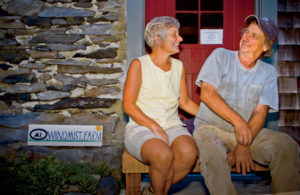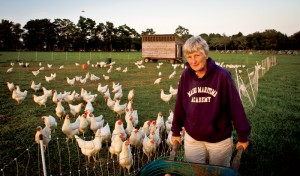A Farm with a View
The slow-food movement, a whole lot of smart management and “location, location, location” are a winning combination that helps the Neale family live a dream at Windmist Farm.
By Jamie Cole | Photos By Jamie Cole
If you’re standing by a fencepost on the western end of Windmist Farm, you can look one way and watch the cars go by on North Road, the one that connects Highway 138 on Rhode Island’s Conanicut Island with downtown Jamestown. You can look the other way and observe a breathtaking view—the same one the folks in those passing cars are snapping their heads around to catch.
It’s an idyllic 40-acre farmstead, striking enough on its own, with its lush pastures and stone-and-shingle barns. To the immediate right is a wildlife preserve, a saltwater marsh owned by the Audubon Society, populated by sandpipers and ospreys.
The backdrop is the Newport Bridge, a blue-green behemoth so forward in the landscape that it seems to deliver motorists right down into the pastures themselves. The island is a short drive from I-95, and the bridge connects Jamestown to Newport, a traditional summer playground for New Englanders.
Long before George and Martha Neale established Windmist, this land was a farm. George has been working cattle here for more than 50 years, since he was just a little kid. George and Martha inherited the land in 2002 when George’s father passed, and in 2007 sold development rights with the help of the Town of Jamestown, USDA, the Champlin Foundation and The Nature Conservancy, preserving its agrarian heritage forever.
George’s full-time work is contracting; he holds two architecture degrees, along with a plant and soil science degree from the University of Rhode Island. Martha’s degree in botany is from URI as well, and she worked as a teacher before coming home for good in 2008 to help run one of the area’s most successful and well-known, local-sourced meat businesses.
Windmist’s location—smack in the middle of the island—makes it ideal for discerning foodies on their way home to Boston and the suburbs of southern Connecticut. The cars on North Road will often slow down just a bit to take in the view.
But it’s the food the farm produces that is worth stopping for.
Oreo Cows
Aside from the landscape, those passing by Windmist might also notice an unusual breed of cattle grazing the pastures. The more than five dozen head of Belted Galloway have a look as distinctive as the farm they belong to—a shaggy, dark-red to black coat with a white “belt” around the midsection. George bought three “Belties” more than 20 years ago now—he remembers calling them Oreo cows back then—and has since built a herd that is as good to look at as it is for business. “I still have the picture, the one he showed me of these belted cows I didn’t know existed,” says Martha.
If the breed is eye-catching to the tourists, it’s a genuine draw for Windmist customers. A coarse, shaggy outer coat makes it well-suited for the chilly New England climate, without the layer of back fat that usually keeps cattle naturally warm. The result is not only lean meat for the customer, but efficiency for the producer; carcass weights are often 60% or more of live weights. At Windmist, Belties are exclusively grass-fed, offering yet another healthy advantage for the foodie customer.
The breed is efficient on grass as well. George put up 400 bales of hay last year, and Martha says they supplemented a bit with some purchased hay, but that it doesn’t take much to keep the herd going. Still, the Belties are a genetically small breed, and George calved his first Beltie-Black Angus matches this year. “We’re trying to see if we can get a little more size on them and grow them faster,” he says. He has high hopes; “those were some chunky calves,” he laughs.
Windmist’s location also allows the Neales to take advantage of an innovative, local process scheduling system. Martha says their beef-processing cycle is the envy of neighboring states, and could serve as a model for others who retail their own beef. Over time, much of the infrastructure for beef processing has shifted—by necessity—to the Midwestern U.S., leaving fewer and fewer USDA-inspected processing facilities behind for the smaller producer. Rhode Island’s answer to such a shortage is the Rhode Island Raised Livestock Association (RIRLA). Founded in 2005 and supported by grants from USDA and other fundraising efforts, RIRLA partners with meat-processing facilities for a soup-to-nuts option for farm retailers: Deliver an animal, receive meat products from said animal already Cryovac®-sealed and frozen. “In other words, ready to sell!” says Martha. The membership fee in RIRLA is based on how many animals you process, and it saves the operator time and money by being a one-stop shop.
The Neales have processed more than 30 lambs this year, and even a few goats. The RIRLA handles them all. And the system is great for the consumer too. The RIRLA system ensures that the meat delivered to the farm retailer is from the correct animal. “We know it’s our animal, so the consumer knows it too,” Martha says.
The Beef-Poultry Connection
George and Martha work with their children to supplement the beef and lamb operations with pork and poultry as well. Oldest son, Cory, helps out when he’s needed; son, Tucker, and his wife, Logan, live on the farm; daughters, Hadley and Chandler, are still in college.
Tucker and Logan both have their hands in the poultry operation. Fresh eggs come from several dozen layer hens that roam free within a movable fence with a mobile chicken house as its hub. Tucker mounted the house on wagon wheels; it and the fence move around the pasture three days behind the cows so the layers can then feast on larvae from the manure piles, aiding with pest and fly control.
Farther out in the pastures, broilers are housed in mobile pens that Tucker rolls around behind the cattle as well. That way the forage is grazed down to a workable size for the chickens to eat, while they lay down nitrogen that enriches the pastures for the next cattle-grazing cycle. The system also saves on feed costs for the chickens; they’ll eat more forage if they’re moved to fresh ground frequently.
Tucker and Martha learned about the system from its guru, Joel Salatin. He estimates you can save 30% or more on feed costs, not to mention savings in pasture fertilization. While Salatin’s broilers often reach market weight earlier than normal, the Neales prefer a slower-maturing Poulet Rouge breed for its hardiness and tasty meat.
“We get them as day-old chicks,” says Martha. “If you hatch them yourselves, you have a depreciating return; the chicks begin to appreciate the day we get them.” They’re in the brooder for two or three weeks and on pasture for eight to 12 weeks. The family produces more than 1,000 meat birds a year.
Marketing and Growth
Martha says word of mouth and location both favor Windmist, while visits to farmers’ markets and direct sales to chefs and grocers through web sites such as Farm Fresh Rhode Island (www.farmfreshri.org) help the Neales clear inventory and sell niche products. “The home cook might not want to mess with beef cheek, but a chef will,” says Martha, noting Farm Fresh RI’s ease of use and quick turnaround. “On the weekends I list what I have available, chefs and grocers place their order on Monday, on Tuesday I get my list of what sold, I pack for delivery on Wednesday, and the restaurant has it on Thursday.” Plus, she says, “it’s great to see our farm’s name on a menu.”
All of this, and the farm continues to expand. Their home garden, for instance, has turned into a year-round functioning greenhouse, thanks to USDA’s seasonal high tunnel program. The Neales’ 1,200-square-foot greenhouse extends their growing season by weeks on either side for vegetables, while providing shelter for greens in the winter. The NRCS-funded program has helped farmers in 43 states build hundreds of high tunnels, including the Neales, who were fully reimbursed for their structure and in return will keep three years’ worth of production records showing the resulting season extension.
Meanwhile, other farms in the area help create something of a “slow-food district” on the island. The Neales credit their neighbors with raising grass-fed beef years before they did, and a farmstand across North Road sells fresh vegetables; all the more reason for weekenders to slide down that Newport Bridge ramp and pick up a little something for the week ahead.
George, Martha and the kids all stay busy, but Martha is the sole full-timer. Still, she says, “I’m living my dream. This is so much better than teaching.” She seems, for a moment, to catch how that sounds, and acquiesces a bit: “I really like kids. I just wish that kids could be grass-fed instead of ‘feedlotted.’ That’s what it comes down to.”
Imagine Martha saying this while she takes in the view of her own farm—the stunner of a landscape, the grazing belted beauties—and it’s easy to see what she means.










